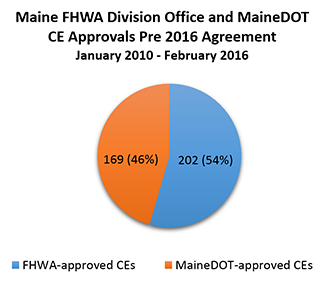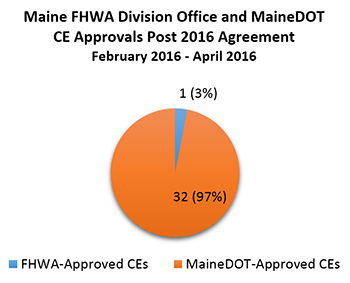
New Programmatic Categorical Exclusion Agreement Creates Potential to Accelerate Projects in Maine
Federal, State, and local agencies across the country have been working together to identify and document potential environmental impacts caused by transportation projects since the National Environmental Policy Act (NEPA) was passed in 1970. Over the past 46 years, the levels of documentation have changed but the intent has remained the same—ensuring that the environment is considered in all Federal agency actions.
In 2014, the Federal Highway Administration (FHWA), as required by Section 1318(d)(2) of the Moving Ahead for Progress in the 21st Century Act, published a final rule that called for all existing programmatic categorical exclusions (PCEs) to be revised and updated. As part of the final rule, FHWA provided State Departments of Transportation (State DOTs) with a template to consider using when updating their PCEs. State DOTs and their partners at FHWA Division Offices across the country have since been revising their PCE agreements. The Maine Department of Transportation (MaineDOT) utilized its strong relationships with the FHWA Maine Division Office to draft a new PCE agreement in 2014. Following that agreement, MaineDOT and the FHWA Maine Division Office implemented an updated PCE agreement in February 2016 that has shown promising results just a few months after execution.
By looking at past project histories and associated risks, MaineDOT and the FHWA Maine Division Office realized their PCE agreement could accelerate the environmental review and approval process by increasing the threshold levels of impact and reducing the number of answers to CE checklist questions that would require FHWA approval. The new Maine PCE agreement is just one approach to the revisions taking place nationwide, but it is worth mentioning that it has significantly streamlined the categorical exclusion (CE) approval process, saving MaineDOT and the FHWA Maine Division Office time that will be better spent implementing projects that have already received NEPA approval. It also provides more time for reviewing other, more time-intensive and higher-risk environmental documents, such as individual and programmatic biological assessments (BAs) prepared as part of the Endangered Species Act Section 7 consultation.
PCEs Should Streamline Environmental Reviews But Often Require Redundant Reviews
NEPA Classes of Action
Class I: Environmental Impact Statement
Actions that significantly affect the environment require an EIS.
Class II: Categorical Exclusion
Actions that do not individually or cumulatively have a significant environmental effect are excluded from the requirement to prepare an EA or EIS.
Class III: Environmental Assessment
Actions in which the significance of the environmental impact is not clearly established. All actions that are not Class I or II are Class III. All actions in this class require the preparation of an EA to determine the appropriate environmental document required.
All State DOT projects that receive Federal funding or require FHWA approval must comply with NEPA, which requires different levels of documentation on projects, depending on which of the three NEPA classes of action the project falls within. An agency must determine the appropriate class of action for a given project, which is either an environmental impact statement (EIS), a CE, or an environmental assessment (EA).
CEs are generally divided into two types: (1) those when a State DOT may determine that a CE is the appropriate class of action, and (2) those when the FHWA Division Office must confirm that a CE is the appropriate class of action. FHWA regulations include lists of actions that FHWA and State DOTs have previously determined to have no significant impacts. Section 771.117(c) of 23 CFR contains specific categories of actions, sometimes referred to as the “C-List,” that meet the regulatory requirements for CEs and normally do not require any further NEPA approvals by FHWA. Examples of C-List CEs include developing rest areas in an existing right-of-way, constructing bicycle or pedestrian lanes, installing noise barriers, and acquiring scenic easements. Section 771.117(d) of 23 CFR, known as the “D-List,” contains a list of additional actions that do not normally result in significant impacts but require studies to document that the CE classification is appropriate and does not require the agency to prepare an EA or EIS.
PCE agreements establish a set of conditions that, if projects meet them, allow a State DOT to determine, document, and approve a CE class of action without approval from FHWA. To further accelerate the CE approval process, State DOTs and their respective FHWA Division Offices, have developed a series of questions with associated thresholds that guide the process of deciding which agency will determine the CE class of action. Each question has a threshold level of impact, and if that threshold is exceeded, the FHWA Division Office must confirm the CE is the appropriate class of action. With its past PCE agreement, MaineDOT found it was sending a high number of CEs to the FHWA Division Office for review, even though the questions were routine and the FHWA Division Office almost always confirmed that the CE class of action was appropriate.
MaineDOT Raises Thresholds in Revised CE Agreement
In 2014, MaineDOT and their FHWA Division Office colleagues began to discuss the existing PCE agreement and to assess additional streamlining measures. Their mutual goal was to create a separate process to demonstrate compliance with applicable Federal environmental laws and regulations prior to NEPA approval. In addition to more effectively documenting environmental compliance, the new process will help to raise awareness within MaineDOT and the FHWA Maine Division Office about all of the environmental laws that project managers must consider during the project development process. The revised PCE agreement stipulates that the new process must be in place by 2017.

Prior to updating the Maine CE agreement, more than half of CEs were sent to FHWA for approvals. (courtesy of MaineDOT)
As part of the recent agreement, the FHWA Division Office and MaineDOT reviewed the previous and current threshold questions to determine if responses to certain questions ever caused a project to be elevated from a CE to either an EA or EIS. If the answer was “no,” after additional analysis of associated risks, the threshold was increased. Under the revised agreement, rather than asking whether a proposed project would have any effect on a specific resource or resources, the MaineDOT and the FHWA Division Office now consider whether the information provided will support processing the project as a CE despite potential effects to a specific resource(s).
The 2014 version of the Maine PCE agreement contained fewer questions than most, but MaineDOT further narrowed the threshold question list from 11 threshold questions to six. During the development of the threshold questions and with input from a member of the FHWA Resource Center, MaineDOT and the FHWA Maine Division Office also considered the inclusion of additional environmental laws and regulations, such as Native American and coastal issues. This ensures the updated PCE agreement would capture all of the applicable environmental laws and regulations requiring compliance under NEPA. The development process for the updated and further streamlined PCE agreement was effective because MaineDOT and the FHWA Maine Division Office have a close and trusting working relationship. This level of partnership enabled the FHWA Division Office to comfortably transfer more responsibility to MaineDOT.
The new PCE agreement requires MaineDOT and the FHWA Maine Division Office to coordinate and collaborate on the development of a formal process for documenting compliance with all environmental laws and regulations, thereby institutionalizing existing practices between the partners. For example, issues related to the Wild and Scenic Rivers Act (WSR Act) are not included in the list of threshold questions, but compliance must occur under certain circumstances. Compliance with the WSR Act and all other environmental laws will provide a more complete and defensible documentation for projects. Those involved in this process have agreed that this approach may not be appropriate for every State, but beginning to have conversations about how to further streamline these processes can lead to significant cost and time savings.
Revised PCE Agreement Will Reduce Number of CEs Sent to FHWA for Approval

Thanks to the new Maine CE agreement, FHWA will review less than 5 percent of MaineDOT CEs. (courtesy of MaineDOT)
Past PCE agreements in Maine were effective, but between 40 to 55 percent of projects were sent to the FHWA Division Office to confirm the CE class of action. If a project was not anticipated to result in adverse impacts to a specific resource, FHWA would still review the project under the prior PCE agreement. The new PCE agreement has reduced the number of questions MaineDOT must answer, which has also reduced the likelihood that the class of action determined by MaineDOT will need to be confirmed by the FHWA Maine Division Office.
Due to these changes, the Division Office anticipates it will receive less than 5 percent of the total number of federal-aid projects proposed by MaineDOT to confirm the CE class of action. Reviewing fewer CEs will allow the FHWA Maine Division Office to focus on those projects that are of higher priority and that have been determined to be high risk.
MaineDOT must still go through the classification process and get approvals for NEPA and all other applicable environmental laws, but the agency will save about three weeks of review time. This means approved projects will likely start sooner than they have in the past. Between February 2016, when the new PCE agreement was signed, and April 2016, MaineDOT approved 32 CEs. More time is needed to measure the ability of the new agreement to reduce the number of CEs that MaineDOT may approve rather than send to the FHWA Division Office, but the initial results are promising.
MaineDOT and the FHWA Maine Division Office will continue to develop and refine the formal process for documenting and ensuring compliance for all environmental laws and regulations. Additionally, the FHWA Maine Division Office plans to conduct multiple program reviews throughout the life of the new PCE agreement to ensure MaineDOT is continuing to process CEs in accordance with the terms of the PCE agreement.
Contact Information
Cassandra Chase
Environmental Engineer
Federal Highway Administration
Maine Division Office
207-512-4921
Cassandra.Chase@dot.gov
David Gardner
Environmental Office Manager
Maine Department of Transportation
207-592-2471
David.Gardner@maine.gov
Rob Ayers
Environment Program Specialist
Resource Center
Federal Highway Administration
708-283-3509
Rob.Ayers@dot.gov
Successes in Stewardship is a Federal Highway Administration newsletter highlighting current environmental streamlining and stewardship practices from around the country. Click here to subscribe, or call (617) 494-3719 for more information.

